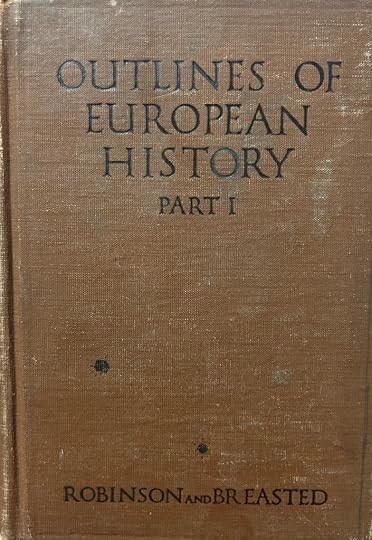The Trajectory of a Book

David Michael Newstead | The Philosophy of Shaving
The book followed an unknowable path to get here. That began when this 730-page edition was published in 1914, the byproduct of two white American academics charting the history of Europe and the ancient world. James Harvey Robinson was a historian, James Henry Breasted an Egyptologist. Then, around 1923, a young black college student purchased the book for her history class at St. Augustine’s School in Raleigh, North Carolina. She took a pen and signed her name in bold ink along the interior edge of the cover’s endsheet. It reads – Elizabeth.
Elizabeth’s book is decorated with extensive notes in pen and pencil, cursive and print. Some of that has faded overtime, but her writing is still quite clear. The inside of the book also contains photographs, a postcard, and a letter as well as miscellaneous slips of paper. All these things provide a detailed, but incomplete jigsaw puzzle of this young woman’s life up until April 1, 1924. Tragically, Elizabeth’s college career was interrupted by tuberculosis and she eventually succumbed to that grueling illness at 20-years-old in 1926. In the aftermath, this book would become an unofficial time capsule and a snapshot of her life when it was still so full of potential. As far as I know, the rest of her personal belongings and any of her writing were lost to time except for this one object. Even contemporary databases only have minimal information about her and her family.
One of the questions that’s dogged me is what happened to this book for a century before I picked it up at a store’s sidewalk discount sale for $4? All I have are theories or, at best, educated guesses. Using records online, I’ve traced a number of possible trajectories as Elizabeth’s loved ones relocated over the years. Because the last of her immediate family members died in the 1950s, I searched under the assumption that other names referred to throughout her book are people who were most likely to have kept it. That may or may not be true, but there’s really nothing else to go on. Roderick, Foy, Fannie, Mrs. Mittie, Eugenia, Warren. Several stayed in North Carolina, but amidst their general movement North to Connecticut and New York, the book might have gone in that direction with them as reading material or a cherished personal keepsake.
The mystery is that none of the book’s identifiable prospective caretakers lived beyond the mid-1980s, which was six decades after Elizabeth’s death and forty years before I found it. That’s a very long time for it to be shuffled around different cities and boxes and bookstores. All the while, everything personal and significant placed between those pages sat undisturbed. I’m based in Washington DC, so whether the book spent all that time in North Carolina, New York, or somewhere else, it eventually made its way here. Perhaps one unknown elderly relative could have helped bridge that gap, but, at some point, the contents concerned a person even they weren’t likely to have ever met.
In reality, most books sit idly by and unopened most of the time. Could this have been one of them? In the last four decades or more, is it possible that no one looked at this book? I wish I knew. A multi-generational journey that I can only guess at brought this book to the present-day, almost exactly a hundred years from its last dated entry. That story contains everything written and unwritten about American history and about the lives of the people who held this object in their hands. Somehow, I have it for the time being, but, no matter what’s on the horizon, it’s always going to be Elizabeth’s. It always was.



